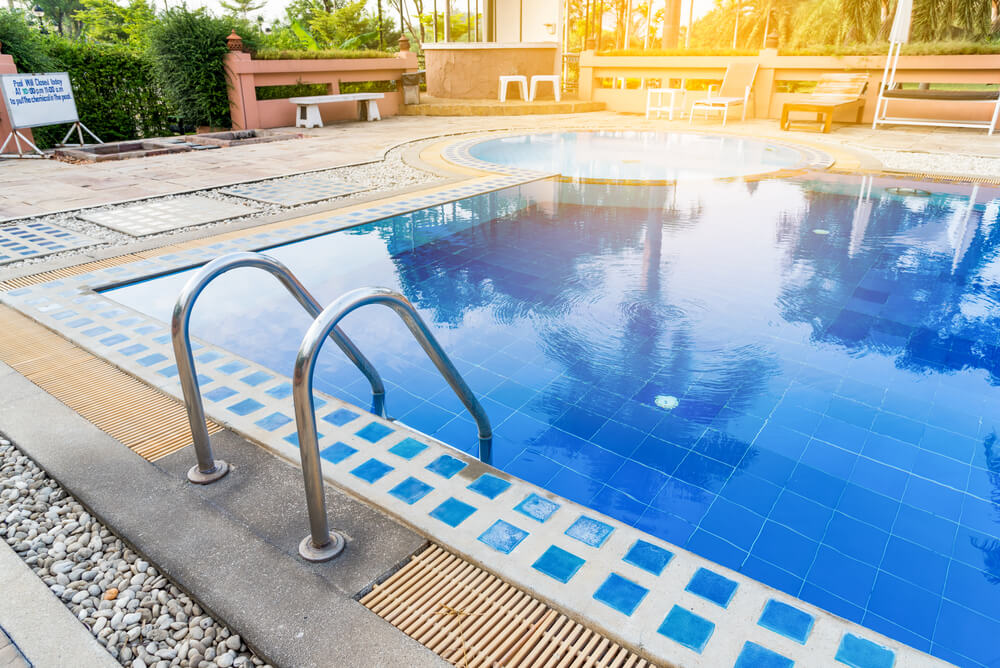Having a pool in your backyard is fantastic, mostly because relaxing after an exhausting day at work while sipping your favorite drink during a hot summer day is hard to top. However, pool surfaces, like many other parts in and around your house, are susceptible to wear and need to be replaced and renovated. There are several pool resurfacing options out there, and even though choosing the best one seems as trivial as choosing the colors for your walls, there is much more to it than meets the eye.
Many people who aren’t aware of the nuances tied to different materials tend to rush their decision and consequently make a mistake that can end up costing quite a bit of money. Therefore, the best way to approach swimming pools resurfacing is to do a bit of research and see which materials would suit your taste the most. For starters, take a moment to check out some of the popular materials we have covered in this article, and you will get a better insight into the pros and cons, which should help you find the best candidate.
Frequently Used Pool Resurfacing Materials
While there are several viable options out there, we will focus on the four most popular ones:
- Plaster
- Pebble
- Concrete
- Tiles
Before we dive deeper into each of these, it’s important to point out that there is no universal “best” solution per se; it all comes down to your personal preferences and, more importantly – budget.
Plaster
Out of the four materials we’ve listed previously, plaster is the least expensive and typically the most popular. It’s relatively simple to maintain and work with, and it also provides a smooth, slick surface. Another great thing about plaster is its effect on the color of the water in your pool. Opting for a lighter color will produce a light, tropical hue, whereas choosing a darker plaster color creates an ambient similar to deeper blue waters.

On the other hand, given that plaster is the most affordable option, it comes with some downsides. First and foremost, its durability is not the greatest, to say the least, and plaster finishes typically require renovation every 5-8 years. This could seem like a long time to some people, but you should ask yourself whether you’re willing to redo your pool every eight years or so. Plaster is a porous material, meaning it’s prone to cracking and chipping, especially in high-frequency areas such as swim-outs or stairs. Due to its porous nature, plaster requires extra care to guarantee the water’s proper chemical balance.
Pebble
Unlike plaster, pebble provides a rougher surface making it harder for bacteria to thrive. It’s also much less prone to cracking and staining than plaster. Pebble is a relatively popular material since it offers great options in terms of colors you can choose, and the sky’s the limit as far as your creativity goes.
Excellent durability is one of the main advantages of this particular material, but some people aren’t too fond of the roughness and its texture in general. If you don’t mind its rough surface, pebble is an excellent long-term investment, and while it’s a heftier investment in comparison to plaster, it’s definitely worth the money. With proper care and regular maintenance, a pebble surface should last at least 20 years.
Concrete
As far as resistance to wear goes, concrete is the absolute king among the materials we’ve covered. However, exceptional durability comes with the price of subpar aesthetics. While it’s true that you can paint a concrete surface in any color you can imagine, it’s typically considered the least aesthetically appealing pool resurfacing material.
One of the great selling points for concrete is easy repairs. Unlike with some other materials, fixing cracks in concrete is a piece of cake and can be done even by the owner.
Tiles
Tiles are somewhat less popular than the three materials mentioned above, but it’s still a viable option for many people. The great thing about tile finishes is that they offer endless options regarding colors, shapes, and designs in general. On top of that, they are incredibly easy to maintain and require only an occasional sweeping or vacuuming. Contrary to popular belief, these are not the same as flooring tiles, so it’s essential to consult a team of professionals before you go out and buy a batch of pool tiles. If you’re looking for the best swimming pool contractors Miami has to offer, call us, and we’ll be more than happy to help you!
The only (significant) downside of tiles is the price. Since there are countless patterns, designs, and colors out there, the price will vary greatly, but you can safely assume that you will pay approximately double the money you would pay for a plaster finish. Is it worth it? If your budget allows it, the answer is – yes, absolutely!

How to Choose the Best Material?
Now that you know a thing or two about the most popular pool resurfacing materials, it’s time to figure out which one of these would be the best option in your case.
Here are some tips you can use to narrow the options:
-
Desired Level of Aesthetic Appeal
It’s no secret that some people spend large amounts of money to create awe-inspiring designs for their pool. While there’s nothing wrong with that particular mindset, it certainly isn’t a cheap endeavor. However, the more you lower your budget, the harder it is to fulfill your creative ideas and, consequently, your pool’s aesthetic appeal. So, if you want a marvelous, breathtaking pool, opting for tiles would be a safe choice. It’s worth pointing out that you can absolutely have a beautiful pool with cheaper materials, but it’s much more challenging to fit your ideas into a more restrictive budget.
-
Willingness to Remodel and Maintain
In other words, if you’re not planning on redoing your pool every couple of years, we strongly recommend going with more durable materials. For instance, pebble and concrete are relatively simple to maintain and should last 15+ years. Concrete is, obviously, a more affordable option, but then again, it comes with the price of limited designs and questionable aesthetics. On the other hand, if you have a smaller pool or don’t use your pool as frequently, opting for plaster would be a good choice.
As far as we are concerned, the best approach is to consider both the pros and cons of each material and make an informed decision based on your own research. Don’t hesitate to contact a contractor and ask them about their professional opinion; they will undoubtedly know which material would work best in your case.
If you would like to know more about pavers, driveway design, and other services we offer, call us or pay us a visit! In case you’re interested in reading more about coping materials, design ideas, and tips on how to choose quality materials for your yard, read our other articles!




